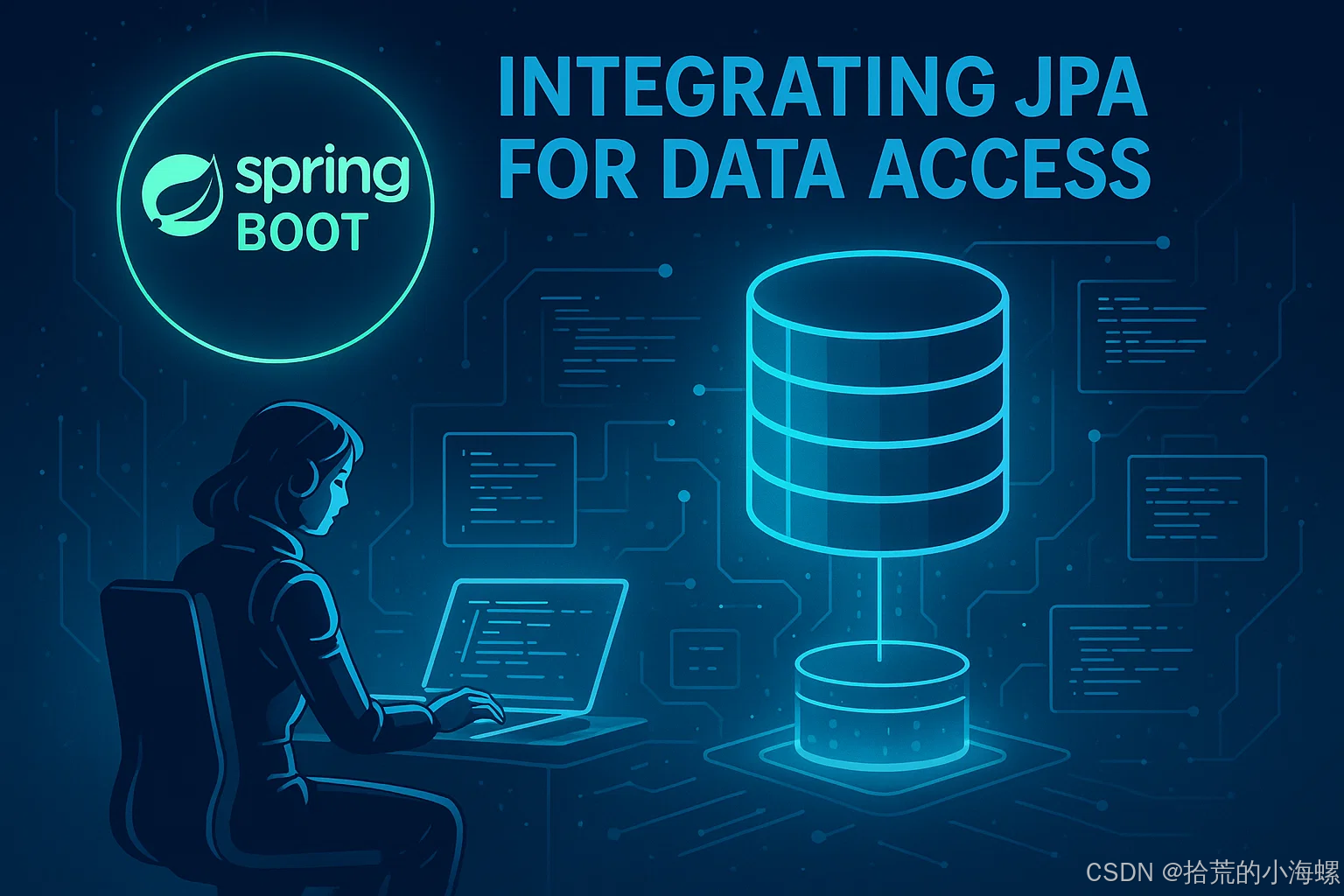1、简述
Spring Data JPA 是 Spring Data 项目的一部分,它提供了一套基于 JPA(Java Persistence API)的持久化数据访问抽象层,使得我们可以通过简单的接口定义和少量的配置,快速实现与数据库的交互。相比传统的 JPA 使用,Spring Data JPA 极大地简化了开发人员的工作,减少了样板代码,提升了开发效率。
🔹 自动化查询方法:只需按照命名规范定义方法,无需手写 SQL 查询。
🔹 分页和排序:内置分页和排序功能,简化数据分页查询。
🔹 自定义查询:支持 HQL(Hibernate Query Language)、JPQL 和原生 SQL 查询。
🔹 动态查询:支持基于 Criteria API 的动态查询。

2、基本配置
在 Spring Boot 项目中使用 Spring Data JPA 需要几个简单的步骤。
2.1 添加依赖
在 pom.xml 中添加 Spring Data JPA 相关的依赖。
<dependencies>
<!-- Spring Data JPA -->
<dependency>
<groupId>org.springframework.boot</groupId>
<artifactId>spring-boot-starter-data-jpa</artifactId>
</dependency>
<!-- H2 Database for Testing -->
<dependency>
<groupId>com.h2database</groupId>
<artifactId>h2</artifactId>
<scope>runtime</scope>
</dependency>
</dependencies>
2.2 配置数据库
在 application.properties 文件中配置数据库信息。这里我们使用 H2 内存数据库作为示例:
spring.datasource.url=jdbc:h2:mem:testdb
spring.datasource.driverClassName=org.h2.Driver
spring.datasource.username=sa
spring.datasource.password=
spring.jpa.database-platform=org.hibernate.dialect.H2Dialect
spring.jpa.hibernate.ddl-auto=update
3、实践样例
3.1 定义实体类
定义一个简单的实体类 User,它将映射到数据库中的 users 表。
package com.example.demo.model;
import javax.persistence.*;
@Entity
@Table(name = "users")
public class User {
@Id
@GeneratedValue(strategy = GenerationType.IDENTITY)
private Long id;
private String name;
private String email;
private int age;
// Constructors, Getters and Setters
public User() {}
public User(String name, String email, int age) {
this.name = name;
this.email = email;
this.age = age;
}
public Long getId() {
return id;
}
public void setId(Long id) {
this.id = id;
}
public String getName() {
return name;
}
public void setName(String name) {
this.name = name;
}
public String getEmail() {
return email;
}
public void setEmail(String email) {
this.email = email;
}
public int getAge() {
return age;
}
public void setAge(int age) {
this.age = age;
}
}
3.2 创建 Repository 接口
Spring Data JPA 提供了丰富的 CRUD(Create, Read, Update, Delete)功能,通过简单继承 JpaRepository 即可。
package com.example.demo.repository;
import com.example.demo.model.User;
import org.springframework.data.jpa.repository.JpaRepository;
import org.springframework.stereotype.Repository;
import java.util.List;
@Repository
public interface UserRepository extends JpaRepository<User, Long> {
// 根据名字查找用户
List<User> findByName(String name);
// 根据年龄查找大于某个值的用户
List<User> findByAgeGreaterThan(int age);
}
3.3 编写服务类
在服务层中,我们可以调用 UserRepository 中的方法来操作数据库。
package com.example.demo.service;
import com.example.demo.model.User;
import com.example.demo.repository.UserRepository;
import org.springframework.beans.factory.annotation.Autowired;
import org.springframework.stereotype.Service;
import java.util.List;
@Service
public class UserService {
@Autowired
private UserRepository userRepository;
// 获取所有用户
public List<User> getAllUsers() {
return userRepository.findAll();
}
// 根据名字查找用户
public List<User> getUsersByName(String name) {
return userRepository.findByName(name);
}
// 根据年龄查找用户
public List<User> getUsersByAgeGreaterThan(int age) {
return userRepository.findByAgeGreaterThan(age);
}
// 保存用户
public User saveUser(User user) {
return userRepository.save(user);
}
}
3.3 创建控制器类
我们可以通过 REST API 来测试这些功能。在控制器中,我们暴露几个 API 接口来与数据库进行交互。
package com.example.demo.controller;
import com.example.demo.model.User;
import com.example.demo.service.UserService;
import org.springframework.beans.factory.annotation.Autowired;
import org.springframework.web.bind.annotation.*;
import java.util.List;
@RestController
@RequestMapping("/api/users")
public class UserController {
@Autowired
private UserService userService;
// 获取所有用户
@GetMapping
public List<User> getAllUsers() {
return userService.getAllUsers();
}
// 根据名字查找用户
@GetMapping("/name")
public List<User> getUsersByName(@RequestParam String name) {
return userService.getUsersByName(name);
}
// 根据年龄查找用户
@GetMapping("/age")
public List<User> getUsersByAgeGreaterThan(@RequestParam int age) {
return userService.getUsersByAgeGreaterThan(age);
}
// 创建用户
@PostMapping
public User createUser(@RequestBody User user) {
return userService.saveUser(user);
}
}
3.4 高级查询
Spring Data JPA 还支持更多的查询功能,例如分页、排序等。
分页和排序:
package com.example.demo.service;
import com.example.demo.model.User;
import com.example.demo.repository.UserRepository;
import org.springframework.beans.factory.annotation.Autowired;
import org.springframework.data.domain.PageRequest;
import org.springframework.data.domain.Pageable;
import org.springframework.stereotype.Service;
import java.util.List;
@Service
public class UserService {
@Autowired
private UserRepository userRepository;
// 分页获取用户
public List<User> getUsersWithPagination(int page, int size) {
Pageable pageable = PageRequest.of(page, size);
return userRepository.findAll(pageable).getContent();
}
}
在控制器中使用:
@GetMapping("/paginated")
public List<User> getUsersWithPagination(@RequestParam int page, @RequestParam int size) {
return userService.getUsersWithPagination(page, size);
}
4、总结
Spring Data JPA 简化了基于 JPA 的数据访问层开发工作,通过丰富的自动化查询功能、分页与排序支持、自定义查询等功能,极大提升了开发效率。开发者可以轻松地实现 CRUD 操作,也可以通过 JPQL、Criteria API 等方式进行复杂的查询。
通过本篇博客,你学会了如何集成 Spring Data JPA 并实现数据库的常见操作,包括自动生成查询、分页和复杂查询的用法。

